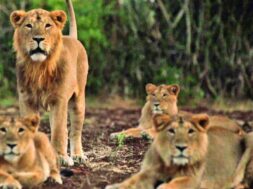
NEW DELHI, Jan 27: A pair of Asiatic lion and lioness with a couple of cubs spotted recently at Sadodar village in Jamjodhpur taluka of Jamnagar district in Gujarat has been making news in wildlife circles across the country indicating it to be a new territory that the king of the jungle seems to be marking out.
The pride’s arrival in this region is yet another milestone in the lion conservation story as the wild cat has now covered almost all districts of the Saurashtra region except Morbi and Devbhumi Dwarka districts.
The forest department is learnt to be considering putting collars on the lions to track their movement, the conquest of yet another territory is taken note of with mixed feelings of joy and concern by conservationists. Saurashtra is facing the towering challenge of balancing port-led industrial development, with the rising need of urban development conflicting with increasing wildlife territories.
In the reverse side, three lions were hit in different incidents by passenger and goods trains as the railway tracks run through some parts of the Gir forest. A lion and a lioness were killed while in another incident a lioness was grievously injured.
Asiatic lions, a thousand years ago, were found in North Africa along the Mediterranean, Asia Minor, India and perhaps a part of Europe. In the Indian subcontinent, the lion was found in Uttar Pradesh, Punjab, Haryana, Bihar, Rajasthan, a part of Madhya Pradesh, Gujarat and Pakistan but for the past 130 years or so, Asiatic lions have been restricted to the Gir forest and its surrounding areas.
In 1884, the population was estimated to be around a few dozens. The first lion census done in 1936 pegged the population at 287. Between 1936 and 1963, the population dipped and stabilised at 285 when the fourth census was conducted. In 1965, 1,412 sq km of the Gir forest was declared a protected area and since then, the population has gradually stabilised and increased to 674 in the latest census in 2020.
Forest department and conservation experts expect the lion population to multiply at 5 per cent annually. The current population is informally pegged at well over 700. This is expected to increase to 2,500 over the next 25 years, putting Gujarat’s forest department in the unenviable position of managing and conserving lion territories under the increasing pressures of urbanisation. The conquest of one more territory by the lions’ couple in Jamnagar is a sign of that mounting predicament.
(Manas Dasgupta)













